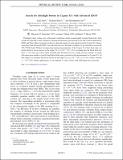Search for ultralight bosons in Cygnus X-1 with Advanced LIGO
Author(s)
Sun, Ling; Brito, Richard; Isi Banales, Maximiliano S
DownloadPhysRevD.101.063020.pdf (1.189Mb)
Publisher Policy
Publisher Policy
Article is made available in accordance with the publisher's policy and may be subject to US copyright law. Please refer to the publisher's site for terms of use.
Terms of use
Metadata
Show full item recordAbstract
Ultralight scalars, if they exist as theorized, could form clouds around rapidly rotating black holes. Such clouds are expected to emit continuous, quasimonochromatic gravitational waves that could be detected by LIGO and Virgo. Here we present results of a directed search for such signals from the Cygnus X-1 binary, using data from Advanced LIGO’s second observing run. We find no evidence of gravitational waves in the 250–750 Hz band. Without incorporating existing measurements of the Cygnus X-1 black hole spin, our results disfavor boson masses in the range 5.8≤μ/(10^{-13} eV)≤8.6, assuming that the black hole was born 5×10^{6} years ago with a nearly extremal spin. We then focus on a string axiverse scenario, in which self-interactions enable a cloud for high black-hole spins consistent with measurements for Cygnus X-1. In that model, we constrain the boson masses in the range 9.6≤μ/(10^{-13} eV)≤15.5 for a decay constant f_{a}∼10^{15} GeV. Future applications of our methods to other sources will yield improved constraints.
Date issued
2020-03-17Department
LIGO (Observatory : Massachusetts Institute of Technology)Journal
Physical Review D
Publisher
American Physical Society
Citation
Sun, Ling, Richard Brito, and Maximiliano Isi. "Search for ultralight bosons in Cygnus X-1 with Advanced LIGO." Physical Review D 101 (March 2020): 063020 ©2020 Author(s)
Version: Final published version
ISSN
1550-7998
2470-0010
2470-0029